Play to Learn: Pretend Play Food Sets
Pretend play food is a great way to introduce new colors, shapes, and food into your kiddo’s play (we like this set!*). You can also play kitchen with the pretend food to introduce new routines! We all know pretend food is a classic toy, and it’s even better when it’s cuttable. You can play with the pretend food in even more ways than before. Our pediatric therapy specialists have shared their ideas to engage with your toddler in play with pretend food, to improve their play, gross and fine motor skills, and speech skills! We have listed some words in parentheses you can use while playing with your little one. Remember to follow your child’s lead and play at their play level!

Combination play with pretend food sets
You can start pretend play with your kiddo by pulling the pieces apart. (You pulled the strawberry apart. Look – there are two pieces!) Then encourage your kiddo to push them together. (Banana. You pushed it together.) Try putting pieces of food in a pretend microwave. (The potato is in the microwave. Push the buttons! We’re cooking. The potato is out. Careful, it’s hot!) You can also try putting the food on toy plates and encourage your child to pretend to eat the food or even carry the food on the plate to a table. This will challenge their balance as well as their attention to a task to make sure they’re moving slow and don’t drop the food! Remember, food play isn’t just for OT and SLPs to work into their sessions – it’s for parents and PT’s too!

Try putting pieces of food in a bowl or pot. (The apple is in the bowl. You dumped the fruit out.) Encourage your toddler to take a toy spoon and stir the fruit in the bowl. (Stir, stir, stir! Look, they are moving around.) Add other steps like scooping the food out and putting the pieces into different bowls or plates. (The lemon is in the bowl. A spoon. You’re mixing the food. The food came out. Now, it’s on the plate.)

This is also a great opportunity to encourage your little one to scoop a piece onto their toy spoon and try to balance it on the spoon, which is harder than balancing it on a plate! You can also cut the pieces with a pretend knife, make sure you show your kiddo how to do it! Watch them and help them if they need it using a hand-over-hand technique. (It’s a knife. We’re cutting the pineapple.) Remember though, the less you do the more your child has to do. Let them fail in low-risk situations like this. Only help the minimum so they can enjoy the rewards of independence and feel like a success!

Pretend Play Promotes Imaginary Play & Advanced Play
Start feeding the food to a puppet or any toy animal that your kiddo likes to play with. You can help sequence a play routine together by encouraging your toddler to push the pieces together, then feed them to the puppet. The puppet can tear the pieces apart while eating, and then your kiddo can stick the pieces together again. (You fed the bunny. He’s eating the lemon. It’s too sour. He spit it out! He wants the carrot!).

This is a great idea for your kiddo to set up a tea party or have all their toys and/or stuffed animals to get together and have a family event! They can imagine their toys sharing food with each other and all eating together. You can practice family routines this way, and encourage your child to set up the table, practice eating, and most importantly – clean up!
Try cutting up the food and then decide with your child what to put in a bowl to make a yummy pizza. This is another way you can practice routines and introduce cooking to your kiddo! You can pretend to prepare the pizza using a plate and fake sauce with bread and cheese. Then put it in the oven (fake or real!) and wait for it to bake. Show your toddler how to set a timer, which is a great way to introduce time and practice their fine motor skills. Make sure to put oven mitts on when taking the pizza out! Encourage your kiddo to blow on the pizza if it’s hot, and then pretend to eat it. (The dough is on the plate. You put a tomato on the dough, it turned into sauce. The pizza is cooking. Oh no it’s too hot! We’re blowing on the pizza. Now, it’s ready to eat. It is cool.)

These are some simple but fun techniques that you can use to encourage pretend play with your child using toy foods. These can be new ways to challenge their play and make it more advanced and engaging as their skills develop. Have fun playing pretend and watching your child learn! We also have tons of awesome information on our resources page, including toys and activities to help your child learn and grow. Never forget though that less is truly more. Fewer cues, verbal instructions, or hand over hand assistance means they’re learning to do things almost on their own. It stands to reason that this will lead to them doing these things independently and having a taste of success when you’re not around, and isn’t that the ultimate goal?
Follow us on Facebook to stay up-to-date on blog posts like this and more! And as always, if you believe your child would benefit from therapy services, contact us to schedule an appointment today.
Written by Sophia Aspin, PT, DPT and Drew Haverstock, PT
* Third-party links in this blog are provided as a convenience and for informational purposes only; they do not constitute an endorsement or an approval by Milestone Therapy of any of the products, services or opinions of the corporation or organization or individual.
